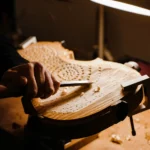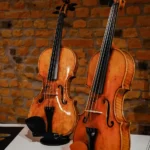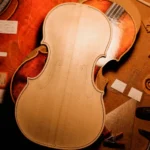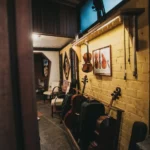The methods of violin-making: the history beyond the instrument
Back to BlogThe world’s most popular instrument has been in this world longer than you think! Violins have been making music for centuries, even before Andrea Amati and Antonio Stradivari started making them in the 16th and 17th centuries. Violin Making history is much longer.
Its popularity rose because of the greater violin makers, among commoners and nobles. All of this came from an extended heritage up until the violin we have today, the instrument had a long, gradual, and complex development—evolving from a few other stringed instruments.
The origins go back a long time: Violin Making History.
The pear-shaped lira played in an upright position and bowed, dates as early as the 9th century. The two-stringed rabab, an Arabian fiddle that came to Europe around the 11th century, the three-stringed rebec from the 11th and 13th centuries, etc. These stringed instruments were present in folk music, but one fascinating fact is that violins only became more standardized after they went to court.
Additionally, another instrument resembled the violin characteristics, the Viol, an instrument made in about the 14th century. Not only were they similar-looking, but also the violin and the viol coexisted in the Baroque period. However, the viol instrument family had a C-shaped soundhole and some more decorative shapes. It also had six, seven, or more strings tuned in fourths, a fretted fingerboard, and a relatively thick body because of the sloping shoulder shape at the joint where the neck meets the body.
Violin made history and has remained for centuries.
The violin as we all know it today only emerged in the early 16th century in northern Italy due to the type of tree that the area had in abundance. Maple and spruce, the two types of wood most favored by violin makers then and since, were responsible for attracting the violin makers and later giving the place the title of the cradle of violin-making and maintaining the longest tradition of violin-makers.
Located in the Lombardy region, the city of Brescia, at the foot of the Alps, was the earliest in the crafting of violins, but Cremona is the one which is called the violin city for hosting the world’s most famous luthiers, Giuseppe Guarneri, Antonio Stradivari, and the Amati family.
The actual form of a violin is a result of many successive changes until it gets to the present one, which has been in use for several hundred years. Experiments have been made since the first sight of the instruments, varying the form, and increasing the sonority, but none of those who made improvements have created instruments with such ability and nobility of tone as did Stradivari, Guarnerius, Amati, and the other great Italian masters.
The Amati family basically founded the tradition of violin making in Cremona. Amati’s instruments had a wooden soundbox with two F-shaped apertures and tuned to fifths, four strings stretched along the instrument’s neck, where they were tightened with pegs. The workshop was a family venture, where he taught the secrets of his craft to his sons, Girolamo and Antonio, by whom later descended the third generation of makers, Girolamo’s son, Nicolò, became the maestro of Andrea Guarneri and Antonio Stradivari.
Apart from this, François Tourte created the modern bow around 1786 and gave it a standard length and weight. In 1820 the chin rest was invented, bringing better playability to the instrument. The 19th century brought length to the neck and the fingerboard, which was an upgrade so musicians could play the highest notes, and also, it was the time when the bass bar was made heavier to produce a bigger, more brilliant sound.
The Italian masters and their legacy
Nicolò Amati
The grandson of Andrea Amati, son, and nephew of two other Amati luthiers, is considered to be the finest craftsman of his family.
Nicolò passed down the tradition of Cremonese violin making to other generations and built a long and rich heritage of makers.
An outstanding aspect of his instruments is that they were somewhat wider than other makers’ instruments, with beautifully shaped soundholes and a strong sound. This design is now called the Grand Amati.
His fine workshop had also been the training place of many apprentices, including Antonio Stradivari.
Antonio Stradivari
Italy’s most notable luthier, without question! Antonio Stradivari created an abundance of stringed instruments, including violas, violins, and cellos, and they were all superlative in all categories of violin’s judgment.
The tone, responsiveness, elegance of design, visual appeal, and precision of Stradivari crafts was higher than any other at the time.
He was an apprentice of Amati but moved to his own style during the 1680s, experimenting with his own soundhole shapes, softer varnish, wider purfling, and a stronger tone.
In 1690 he worked his “long pattern” by narrowing the body and producing a darker tone.
Around 1700, Stradivari returned to the shorter, wider design, which was his “golden age.”
Guarneri Family
Andrea Guarneri worked with Amati until 1698, and many of his violins followed the small Nicolò pattern, but not always well finished. On the other hand, the second son of Andrea, Joseph, stuck out with finer work. The great Giuseppe Guarneri ‘filius Andrea’ did his instruments as narrow-waisted boldly curved, based on the Brescian looking sound-holes, very rich varnish. The fine wood gave these instruments an outstanding appearance.
The young Giuseppe owed his teaching, most probably according to Haweis, to his uncle and cousins. Nothing about Giuseppe Guarneri ‘del Gesù’ is more remarkable than the determined way he examined Amati’s model and was inspired by this Brescian model. Violinist and composer Niccolò Paganini owned four of the robust violins crafted by Guarneri.
Following in the Guarneri family, Pietro Guarneri seemed to have distanced himself from the craft of the family. The distance between the F-holes is conspicuous; the F-holes themselves are rounder and less Brescian, the scrolls are beautifully cut, and the varnish moved from the golden tints to a pale red.
The home of the Violin
Cremona received instruments from all over the globe, and many of the great masters held their workshops in the city. Alongside Stradivari’s, there were instruments by Guarneri del Gesù and Niccolò Amati, plus several by less sought-after Cremonese Masters from the 17th and 18th centuries.
And since then, this has been a place to teach, learn and create marvelous instruments. Most of the violin models and patterns followed today come from when makers like Guarneri and Stradivari revolutionized the concept of fine instruments.









